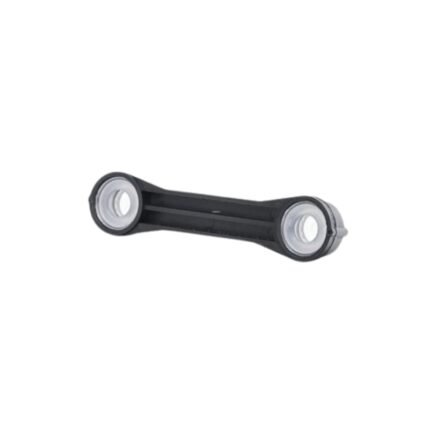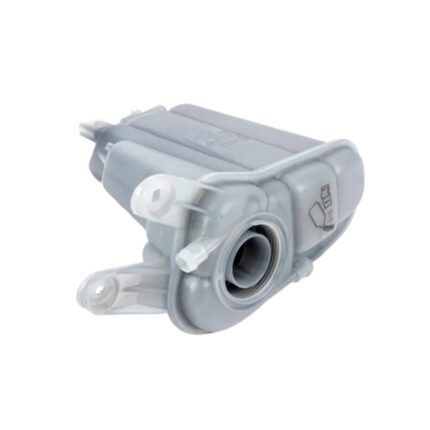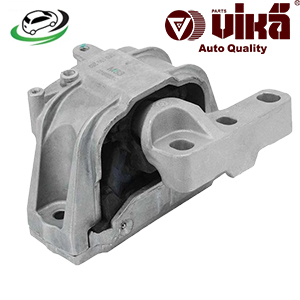Get Right Engine Mount Audi A3 8P 2.0T/Volkswagen Beetle/CC/EOS/Golf V/V1/Jetta V1/V/Passat B6/B7 1K0199262M
The engine mount is a crucial component in a vehicle’s drivetrain system, providing support and stability to the engine and transmission. It serves several important functions that contribute to the overall performance, safety, and comfort of the vehicle. In this comprehensive overview, we will explore the construction, functions, types, common issues, signs of failure, and maintenance of engine mounts.
Construction and Function of Engine Mounts
Construction:
Engine mounts are typically constructed from a combination of metal and rubber. The metal parts provide the necessary structural support, while the rubber elements offer flexibility and vibration damping. Some modern engine mounts also incorporate hydraulic or fluid-filled chambers to enhance vibration isolation.
Function:
- Support and Stability: Engine mounts secure the engine and transmission to the vehicle’s chassis, ensuring they remain in place during operation. This stability is essential for the proper alignment and functioning of the drivetrain components.
- Vibration Isolation: One of the primary functions of engine mounts is to dampen and isolate vibrations generated by the engine. The rubber or hydraulic elements absorb these vibrations, preventing them from being transmitted to the chassis and cabin. This results in a smoother and quieter ride.
- Shock Absorption: Engine mounts also absorb shocks and impacts from the road, protecting the engine and transmission from damage. This is particularly important when driving on rough or uneven surfaces.
- Alignment and Positioning: Properly positioned engine mounts maintain the correct alignment of the engine and transmission, ensuring optimal performance and reducing wear on other drivetrain components.
Types of Engine Mounts
There are several types of engine mounts, each designed to meet specific performance and comfort requirements:
- Rubber Engine Mounts: These are the most common type and consist of a rubber block sandwiched between two metal plates. They provide good vibration isolation and are relatively inexpensive.
- Hydraulic Engine Mounts: These mounts contain a fluid-filled chamber that enhances vibration damping. They offer superior performance in isolating engine vibrations and are commonly used in luxury and high-performance vehicles.
- Solid Engine Mounts: Made entirely of metal, these mounts provide maximum support and stability but offer little to no vibration isolation. They are typically used in racing and high-performance applications where engine movement needs to be minimized.
- Active Engine Mounts: These advanced mounts use electronic controls to adjust their stiffness and damping characteristics in real-time. They offer the best of both worlds: excellent vibration isolation and stability, adapting to different driving conditions.
Common Issues with Engine Mounts
Engine mounts, like any other vehicle component, can wear out or fail over time. Common issues include:
- Wear and Tear: The rubber elements in engine mounts can degrade over time due to exposure to heat, oil, and other environmental factors. This degradation reduces their ability to isolate vibrations effectively.
- Cracks and Breaks: Physical damage to the engine mounts, such as cracks or breaks in the rubber or metal components, can compromise their structural integrity.
- Fluid Leaks: In hydraulic engine mounts, leaks in the fluid-filled chamber can reduce their effectiveness in dampening vibrations.
- Loose or Broken Mounting Bolts: The bolts securing the engine mounts to the chassis or engine can become loose or break, leading to instability and increased engine movement.
Benefits of Engine Mounts
1. Vibration Isolation
Function: Engine mounts are designed to absorb and isolate vibrations generated by the engine. This is achieved through the use of rubber or hydraulic elements that dampen engine vibrations before they are transmitted to the vehicle’s chassis and cabin.
Benefits:
- Smoother Ride: By reducing vibrations, engine mounts contribute to a smoother and more comfortable driving experience.
- Reduced Cabin Noise: Effective vibration isolation helps keep engine noise and vibrations from intruding into the passenger compartment, enhancing overall ride comfort.
2. Engine and Transmission Support
Function: Engine mounts secure the engine and transmission to the vehicle’s chassis, providing necessary support and stability.
Benefits:
- Proper Alignment: Ensures that the engine and transmission are correctly aligned, which is essential for optimal drivetrain performance and longevity.
- Prevents Excessive Movement: Helps minimize engine movement during acceleration, braking, and gear changes, which reduces stress on drivetrain components.
3. Shock Absorption
Function: Engine mounts absorb shocks and impacts from the road, protecting the engine and transmission from damage.
Benefits:
- Protection of Components: Shields the engine and transmission from excessive stress and potential damage caused by road imperfections and driving conditions.
- Improved Durability: Enhances the durability and lifespan of engine and transmission components by minimizing the impact of shocks.
4. Improved Handling and Stability
Function: By securing the engine and transmission in place, engine mounts contribute to the vehicle’s overall handling and stability.
Benefits:
- Enhanced Driving Dynamics: Properly mounted engine components help maintain vehicle stability and improve handling, especially during turns and maneuvers.
- Consistent Performance: Ensures that the engine and transmission operate smoothly and consistently, contributing to a reliable driving experience.
5. Reduced Noise Levels
Function: Engine mounts play a role in dampening engine noise, keeping it from reaching the cabin.
Benefits:
- Quieter Cabin: Helps create a quieter and more pleasant driving environment by minimizing the transfer of engine noise into the passenger compartment.
- Enhanced Comfort: Reduces the level of noise and vibrations experienced by passengers, contributing to overall driving comfort.
6. Prevention of Engine Damage
Function: Engine mounts prevent excessive engine movement that could lead to misalignment or damage to the engine and other drivetrain components.
Benefits:
- Reduced Risk of Engine Damage: Minimizes the risk of engine misalignment and potential damage to engine mounts, belts, and hoses.
- Maintenance of Drivetrain Integrity: Helps ensure that the engine and transmission remain securely positioned, reducing the likelihood of damage to other drivetrain components.
7. Enhanced Vehicle Safety
Function: Properly functioning engine mounts contribute to the overall safety of the vehicle by ensuring that critical components remain securely in place.
Benefits:
- Safe Operation: Prevents excessive engine movement that could affect vehicle control or stability, especially during sudden maneuvers or emergency situations.
- Reduced Risk of Component Failure: Helps maintain the integrity of the drivetrain, reducing the risk of component failure that could impact vehicle safety.
8. Improved Engine Performance
Function: By ensuring that the engine is properly supported and aligned, engine mounts contribute to optimal engine performance.
Benefits:
- Efficient Operation: Proper alignment and support help the engine operate efficiently, which can improve overall performance and fuel economy.
- Consistent Power Delivery: Ensures that power is transmitted smoothly from the engine to the transmission and ultimately to the wheels, contributing to consistent and reliable vehicle performance.
9. Cost-Effective Maintenance
Function: Engine mounts are relatively straightforward to inspect and replace compared to other drivetrain components.
Benefits:
- Ease of Replacement: Engine mounts are generally easier and less expensive to replace compared to more complex drivetrain components.
- Preventive Maintenance: Regular inspection and timely replacement of engine mounts can prevent more severe issues and costly repairs, making it a cost-effective aspect of vehicle maintenance.
10. Customization and Performance Upgrades
Function: For performance enthusiasts, aftermarket engine mounts are available that offer enhanced performance characteristics.
Benefits:
- Improved Performance: Upgraded engine mounts can provide quicker and more precise shifts, better handling, and reduced engine movement, catering to specific driving styles and preferences.
- Customization Options: Allows for customization of the vehicle’s performance to meet individual driving needs or preferences.
Signs of a Failing Engine Mount
1. Excessive Engine Vibration
One of the most noticeable signs of a failing engine mount is increased vibration in the cabin. If you feel unusual vibrations or a harsh shaking, especially when idling or accelerating, it may indicate that the engine mount is worn out or damaged. The rubber or hydraulic components of the mount are designed to absorb and isolate vibrations, and when they fail, these vibrations are transmitted to the vehicle’s interior.
2. Engine Movement
If you observe excessive movement or rocking of the engine, particularly when accelerating, decelerating, or shifting gears, it could be a sign that the engine mount is not providing adequate support. The engine should remain relatively stable and aligned, and excessive movement may indicate that the mount has lost its ability to hold the engine securely.
3. Clunking or Banging Noises
Unusual clunking, banging, or thumping noises coming from the engine bay, especially when going over bumps or during sudden acceleration, often signal a problem with the engine mount. These noises result from the engine moving more than it should, causing it to hit or rub against other components.
4. Engine Misalignment
A visibly misaligned engine, where the engine appears tilted, shifted, or out of its normal position, is a clear indicator of engine mount issues. Misalignment can affect the engine’s performance and potentially lead to other drivetrain problems.
5. Increased Engine Noise
Failing engine mounts can allow the engine to come into closer contact with other components or the vehicle’s frame, leading to increased engine noise. If you notice a rise in engine noise that wasn’t present before, it may be related to mount failure.
6. Unusual Driving Feel
If the vehicle feels unstable or if you experience unusual driving sensations, such as a rough ride or difficulty in handling, it could be a sign of faulty engine mounts. Properly functioning mounts help maintain vehicle stability and driveability.
7. Visible Damage
During a visual inspection, if you see cracks, tears, or significant wear on the engine mounts, it’s a strong indication that they need to be replaced. Rubber mounts are particularly susceptible to degradation from heat, oil, and environmental factors.
8. Engine or Transmission Movement During Gear Changes
In manual transmissions, if you notice that the engine or transmission moves excessively when changing gears, it may be due to worn or damaged engine mounts. Proper mounts help ensure that the engine and transmission remain in their correct positions during gear changes.
9. Rough Idling
A rough or shaky idle can be a symptom of failing engine mounts. If the mounts are not adequately isolating vibrations, the engine’s vibrations can cause noticeable shaking while idling.
Follow us on Facebook for more parts.



